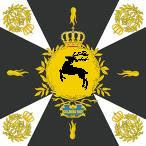So, after much delay and hold-ups, the battle finally happened. And the Luftberg army slips away intact, to fight another day, thanks to the newly arrived Tobias Ludwig. No small achievement, but getting Erich von Kleintrink was also a massive bonus. Will the Aschenbach cavalry ever again have quite the same zip? Only time will tell.
The new basing makes it possible, in a big way. The forces would’ve looked pretty lean and uninspiring under the old system, but the new basing makes them look much more substantial. Also, I made a few improvements on appearances in other ways, such as working out how to take photographs without the flash and having a little tripod stand to reduce blurs in close-up shots. The resulting pics are definitely more colourful and bright, as my old photos tended to cast big shadows on the background. I also began using unrolled balls of cotton wool for smoke, which are required as game markers to show ‘fired’ units. I had used tufts before, but now with more figures per unit, it seemed better to have them produce thick blankets of musket-smoke. I quite like the look of them!
On a practical level, the game was played out using my usual Might & Reason Rules set (still excellent) and caused the uncontrolled Von Kleintrink to wreck any hint of tactics. I had initially envisioned the game as a long-running hit-and-run race between columns trying to cut each other off along a road, but it didn’t turn out that way. Each army had only two ‘junior’ commanders, who simply wound up colliding headlong. In M&R, your army general gets ‘command dice’ which he uses to reroll other dice that don’t suit him – the better the general, the more command dice he gets. With only sub-commanders present, they basically knocked about as they chose – attempts to activate them frequently wound up with them becoming ‘inert’ when action was required, and on occasions where disengaging and manoeuvring was the best option, commanders rolled ‘attack!’ options that sent them plunging headlong into disastrous situations. Von Kleintrink seems to be very much the aggressive subordinate, ill-suited to independent command but very good when placed under some steady direction from Von Krumper. Perhaps it’s best for von Kleintrink to be out as a casualty, rather than having to report back on his failure and explain how he got a prime regiment of Cuirassiers shot to fragments for no gain.
Ludwig did a good job with his infantry, considering they had no reserves or artillery support, and there was even a surprise discovery. The Croats had made it onto the flank of the Aschenbach line, but their fire proved as undecisive as ever (they were at half-strength, because I had, erm, only painted one base.) I was at a loss how they could prove useful – clearly I’m just not a ‘light infantry’ sort of wargamer – when the Luftberg infantry charged to close combat (a standard move for Luftberg, who can’t outshoot their opposite numbers in a one-to-one firefight) but as I read the rulebook, I realised that the outflanking bonus in close combat counted for light infantry as well as formed infantry, and it didn’t matter how strong they were.
At last, a genuine bonus for the previously ill-used irregulars, who can now hover menacingly on the flank of any line and prove endlessly enervating for attacking enemies. At full-strength, even firing on flanks will prove painful, while the -3 dice roll modifier for flanking in close combat means they are able to tip the scales against most attacks. They are also pretty difficult to scare away, so it looks like the Luftberg army will abandon it’s previous practice of sticking the Croats under the worst commander and leaving them ‘inert’ in some isolated backwater.
Well, that’s enough chat for now, but I’ll be back soon to cover the next step in the campaign in the imagination world, and the progress of my massive miniatures expansion project in the real world.




 The Cuirassiers of Von Kurbitz (KR2) found themselves being pounded by three enemy regiments, and were wrecked by the disorganising fire. Luftberg’s cavalry were similarly battered and finally pulled back, but the infantry proved able to resist the charges of Von Flunck’s dragoons on the end of their line.
The Cuirassiers of Von Kurbitz (KR2) found themselves being pounded by three enemy regiments, and were wrecked by the disorganising fire. Luftberg’s cavalry were similarly battered and finally pulled back, but the infantry proved able to resist the charges of Von Flunck’s dragoons on the end of their line. 


 Von Fleiger’s Dragoons and Kurbitz’s Cuirassiers galloped forward and clashed with their opposite numbers, respectively Klimt’s Cuirassiers and Raab’s Dragoons. The combat was speedy and brutal, with both armies’ infantry rushing to position behind the melee of horsemen. The combat was largely inconclusive, with the Cuirassiers generally having the upper hand over Dragoons, and Von Kleintrink possessed of a deathwish as ever and heroically threw himself into combat to encourage them on. However the Luftberg line took the impact and the Aschenbach horsemen were forced back to reform, galloping back between the columns of oncoming infantry.
Von Fleiger’s Dragoons and Kurbitz’s Cuirassiers galloped forward and clashed with their opposite numbers, respectively Klimt’s Cuirassiers and Raab’s Dragoons. The combat was speedy and brutal, with both armies’ infantry rushing to position behind the melee of horsemen. The combat was largely inconclusive, with the Cuirassiers generally having the upper hand over Dragoons, and Von Kleintrink possessed of a deathwish as ever and heroically threw himself into combat to encourage them on. However the Luftberg line took the impact and the Aschenbach horsemen were forced back to reform, galloping back between the columns of oncoming infantry. 
